Gel nails have gained immense popularity in recent years, thanks to their durability and long-lasting finish. However, when it comes time for removal, many individuals find themselves unsure of the correct method and duration for soaking gel nails in acetone. In this article, we will explore the ideal soaking time and provide you with an official guide to ensure a hassle-free and effective gel nail removal process.
Removing gel nails can seem like a daunting task, especially if you’re doing it at home. One of the most common methods for removing gel polish is soaking the nails in acetone. It’s effective, relatively straightforward, and when done correctly, can protect your nails from potential damage. Here’s a step-by-step guide on how to safely soak off your gel nails using acetone.
What You Will Need:
- Acetone (pure, not diluted)
- Small bowl
- Aluminum foil
- Cotton balls or pads
- Nail file
- Cuticle pusher or orange stick
- Nail buffer
- Moisturizer or cuticle oil
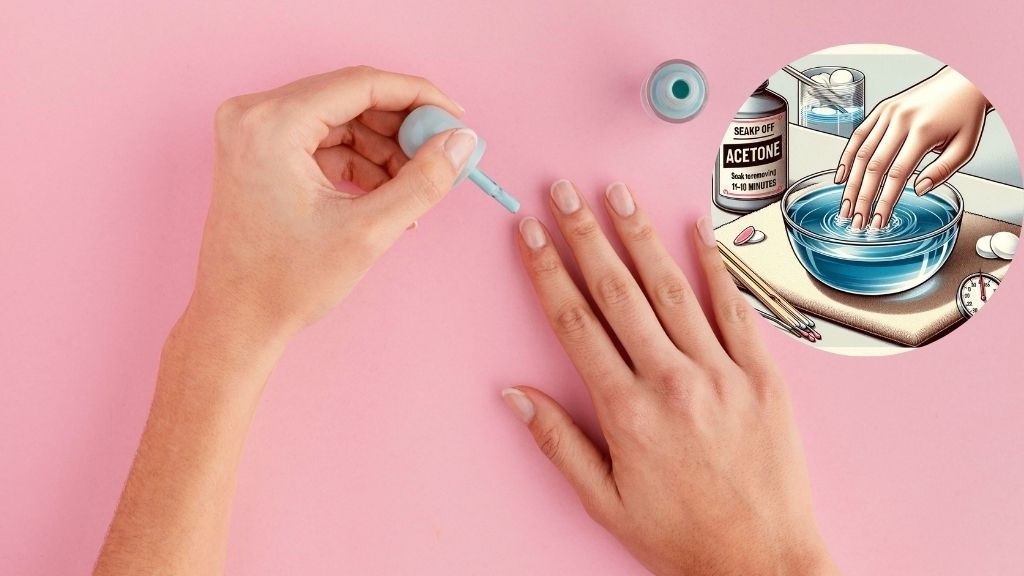
Step 1: Filing the Top Coat
Start by gently filing the surface of your gel nails with a nail file. The aim is to remove the shiny top coat and create a rough surface, which allows the acetone to penetrate more effectively. Be careful not to file too deeply to avoid damaging the natural nail underneath.
Step 2: Preparing the Acetone Soak
Pour acetone into a small bowl, just enough to cover your nail tips. For added skin protection, you can apply a thin layer of petroleum jelly around your nails to guard against the drying effects of acetone.
Step 3: Soaking Cotton Balls
Take cotton balls or pads and soak them in the acetone. Make sure they are well saturated but not dripping excessively.
Step 4: Wrapping the Tips
Place the soaked cotton balls on top of your gel nails and then wrap your fingertips with aluminum foil to secure them. Ensure the foil is snug but not too tight, as this could cause discomfort or restrict blood flow.
Step 5: Time to Soak
Now, for the crucial question: how long should you soak your nails in acetone? Typically, it takes about 10 to 15 minutes for the acetone to break down the gel polish. This can vary depending on the type of gel polish and how many layers you’ve applied.
Step 6: Checking the Progress
After 10 minutes, carefully check one nail by removing the foil and cotton ball. The gel polish should appear to be lifting away from the nail and can be gently pushed off with a cuticle pusher or an orange stick. If the polish is stubborn, reapply the cotton ball and foil, and soak for an additional 5 minutes.
Step 7: Removing the Residue
Once the gel polish has loosened, use the cuticle pusher to gently scrape away the polish. Avoid using too much force which can damage the nail bed.
Step 8: Buffing the Nails
After all the gel has been removed, there might be a bit of residue left. Buff your nails gently with a nail buffer to get rid of any remaining polish.
Step 9: Aftercare
Acetone can be very drying, so it’s important to wash your hands with soap and water and then apply a moisturizer or cuticle oil to rehydrate your nails and cuticles.
Removing gel nails with acetone requires patience and care. It’s important not to rush the process or forcefully scrape the polish off, as this can lead to nail damage. Instead, take your time, follow the steps, and give your nails some TLC after the acetone soak. With the right approach, your natural nails will remain healthy and ready for the next manicure adventure.
Read more: how much does a manicure & pedicure usually cost for a man
What is a gel nails vs acrylic nails?
Gel nails and acrylic nails are both popular nail enhancement options, used to lengthen and strengthen nails while providing a well-groomed, polished appearance. Although they may seem similar at a glance, they have distinct differences in terms of application, composition, appearance, durability, and removal process. Here’s a breakdown of gel nails versus acrylic nails:
Gel Nails: Acrylic nails are made by mixing a liquid monomer and a powder polymer to create a hard protective layer over the natural nail or to sculpt a longer nail. The mixture hardens when exposed to air. Acrylic nails are known for their durability and strength. They can be filed into various shapes and sizes. However, they might look less natural than gel nails if not applied properly. Acrylic nails require regular fills as the natural nail grows and can be removed by soaking in acetone.
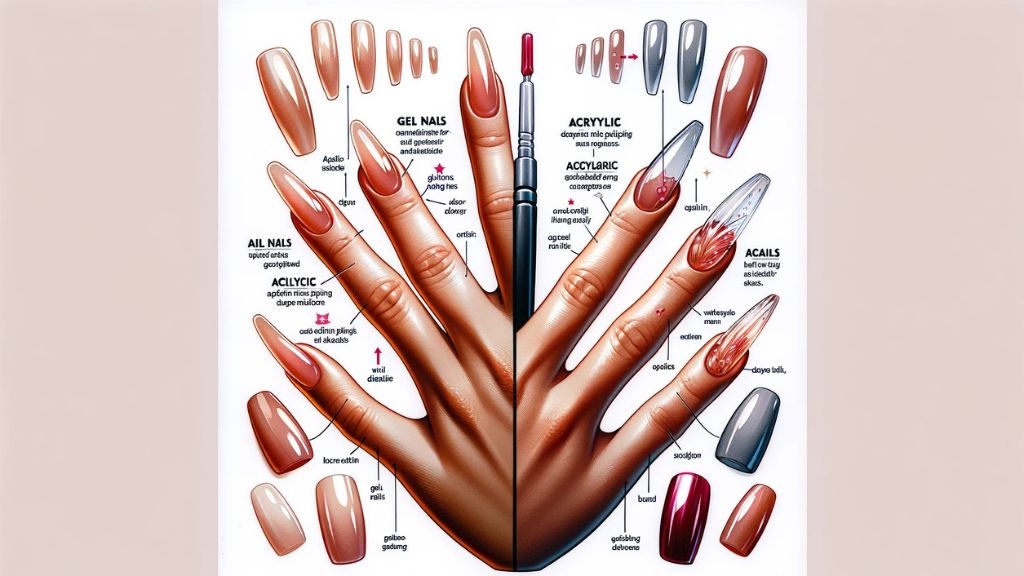
- Composition: Gel nails are made of polymer resins that are “cured” under UV or LED light. The light causes the gel to harden and adhere to the nail.
- Application: Gel can be applied in several forms, including gel polish (like Shellac), hard gels, or gel tips. They can’t be used to extend the nail unless a tip is applied or sculpted using building gel.
- Appearance: Gel nails tend to have a more glossy and natural look. They are more flexible than acrylics.
- Durability: While gel nails are durable, they are typically not as strong as acrylic nails. They are less prone to lifting, which can be a plus for the health of the natural nail underneath.
- Maintenance: Gel nails may require more frequent maintenance visits to the salon, usually every two to three weeks, as they grow out with the natural nail.
- Removal: Gel nails should be soaked off with acetone, and the process can take longer than acrylics. It is often necessary to avoid peeling or picking them off to prevent nail damage.
Acrylic Nails: Gel nails involve applying layers of a gel-based polish to the natural nails, which then need to be cured under a UV or LED light to harden. Gel nails tend to have a more glossy and natural appearance compared to acrylics. They are less durable than acrylic nails but are more flexible, which some wearers find more comfortable. Gel nails can also come in the form of hard gel, which can be used to sculpt nail extensions similar to acrylics, or soft gel (gel polish) for a more natural enhancement. Gel nails also require fills as the nail grows out and can be removed by soaking in acetone, but removal tends to be easier and less damaging to the natural nail than acrylics.
- Composition: Acrylic nails are created with a mixture of liquid monomer and a powder polymer that forms a hard protective layer over the natural nail when exposed to air.
- Application: The acrylic mixture is applied to the nails and shaped as it hardens. It can be used to extend the length of the nails by using nail forms or adding artificial tips before applying the acrylic.
- Appearance: Acrylics are less shiny than gel but can be polished to a high shine. They can appear thicker and less natural than gel if not applied skillfully.
- Durability: Acrylic nails are very strong and durable, making them a good option for those with weak or brittle nails. However, if they catch on something, they can completely break off.
- Maintenance: Acrylic nails usually require fill-ins every two to three weeks as they grow out and the natural nail appears at the base.
- Removal: Acrylic nails can be soaked off with acetone, but they are usually easier to remove than gel nails because the acrylic dissolves rather than just softening
Health and Safety Considerations:
- Gel nails require exposure to UV light, which has raised some concerns about skin safety. Using sunscreen on your hands can help mitigate this risk.
- Acrylic nails can be harsher on the natural nail and can increase the likelihood of an allergic reaction to the chemicals used in the application process.
In conclusion, the choice between gel and acrylic nails often comes down to personal preference, the desired look, and the condition of your natural nails. Both types require professional application and proper removal to maintain the health of your natural nails. It’s also important to go to a reputable salon where the technicians use sanitary tools and practices to prevent infections.
Both types have their advantages and disadvantages, and the choice between gel and acrylic nails often comes down to personal preference, lifestyle, and the look one aims to achieve. Acrylic nails are a good option for those looking for length and durability, while gel nails are best for those seeking a more natural look and a less damaging removal process.
How often should I remove my gel in acetone a month?
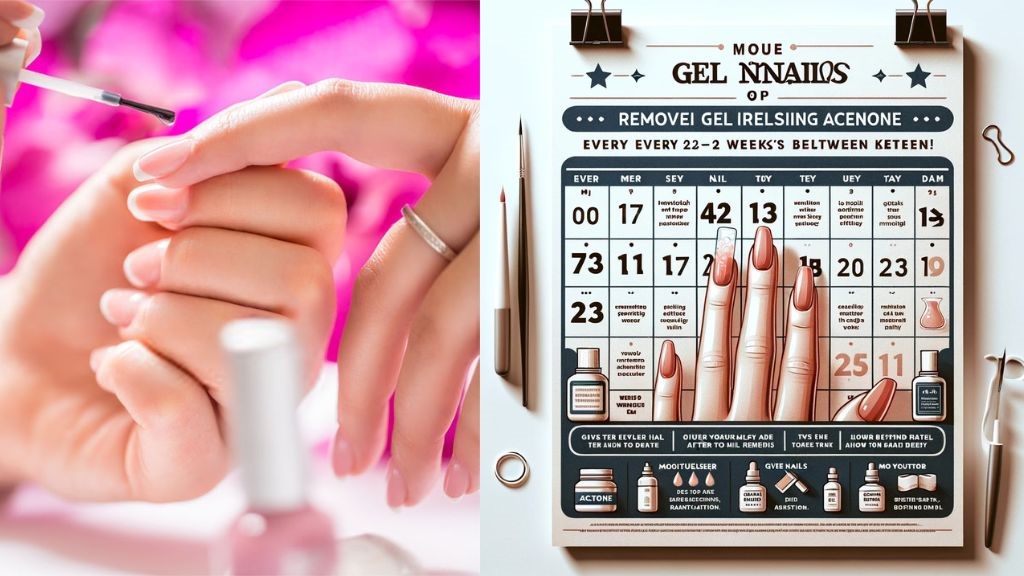
Removing gel polish from your nails typically involves using acetone, which can be quite harsh on the natural nail and surrounding skin. How often you should remove gel polish in acetone depends on several factors including the health of your nails, how quickly your nails grow, and the longevity of the gel polish application itself.
Here’s a general guideline for gel polish removal:
- Gel Polish Lifespan: Gel nail polish usually lasts about 2-3 weeks without chipping or peeling. Once it begins to lift or if new nail growth is visible, it’s time to consider removal.
- Nail Health: If you notice that your nails have become weak, brittle, or damaged, it’s a good idea to give them a break from gel polish to allow them to recover. Frequent exposure to acetone can exacerbate these issues.
- Removal Process: Ensure that you’re removing the gel polish gently and correctly. Rushing the process or using force can damage the nail bed and cuticles. If removal is frequently causing damage, you may want to extend the time between applications.
- Breaks Between Applications: It’s beneficial for your nail health to take breaks between gel applications. After removing the gel polish, try to leave your nails bare for at least 1 week to allow them to rehydrate and repair. During this period, you can treat them with nail strengtheners, cuticle oil, and hand cream to restore moisture and strength.
- Professional Advice: Consult with a professional nail technician for advice tailored to your nail’s condition. They can recommend the best schedule for your gel manicures and provide tips for nail care between appointments.
- Alternating Manicures: Some individuals choose to alternate between gel and less damaging manicures, such as regular nail polish, to reduce the frequency of acetone exposure.
Remember, while gel nails offer a long-lasting and chip-resistant finish, the health of your nails should always come first. Pay attention to how your nails respond to gel polish and acetone, and adjust your manicure routine accordingly.
Does soaking gel nails in acetone cause cancer?
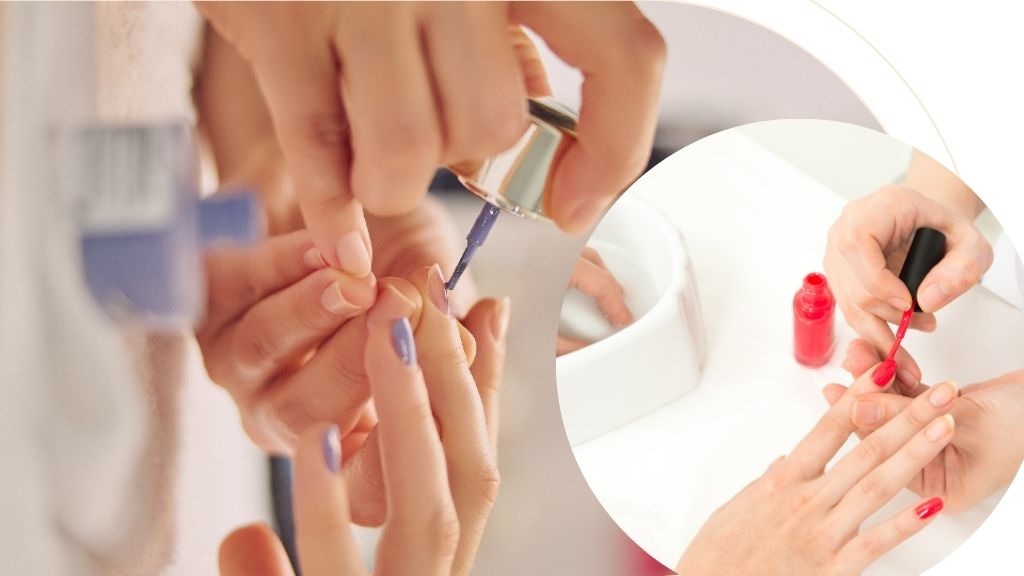
The question of whether soaking gel nails in acetone can cause cancer is a topic of health and safety concern. Acetone is a commonly used solvent in the beauty industry, particularly for removing gel nail polish. It is known for its effectiveness in breaking down and dissolving the gel polish, allowing for easier removal.
However, regarding the potential for causing cancer, it’s important to understand that cancer risk is often associated with exposure levels and the inherent properties of a substance. Acetone is classified as a generally low-toxicity substance when used in controlled amounts and with appropriate precautions. According to the International Agency for Research on Cancer (IARC) and the U.S. Environmental Protection Agency (EPA), acetone is not classified as a carcinogen to humans. This means that, based on the current scientific evidence, there is no direct link established between acetone exposure and cancer risk.
The primary concerns with acetone use are related to its potential to irritate the skin, eyes, and respiratory system in high concentrations or with prolonged exposure. It is also a highly flammable liquid. When using acetone, it’s crucial to use it in a well-ventilated area, avoid prolonged skin contact, and follow the product’s safety instructions to minimize any health risks.
For those concerned about the potential health impacts of using acetone for gel nail removal, there are acetone-free nail polish removers and other methods available that may be considered safer alternatives. However, these alternatives might not be as effective on gel polish and could require more effort or time to remove the polish.
In summary, while acetone is effective for removing gel nails, it is not classified as a carcinogen, and there is no direct evidence linking its use to an increased risk of cancer. Still, it is always advisable to use such chemicals with proper precautions and consider alternatives if there are concerns about safety or health impacts.
What are some alternatives to acetone for women?

Acetone is a powerful solvent widely used in industrial, laboratory, and consumer applications, especially known for its effectiveness in removing nail polish. However, its strong nature can sometimes be too harsh for certain materials or undesirable due to its smell and chemical properties. Here are some alternatives to acetone:
For Nail Polish Removal
- Ethyl Acetate: Commonly found in non-acetone nail polish removers, it’s gentler on the nails and skin.
- Isopropyl Alcohol: While not as effective for all types of nail polish, it can work in a pinch and is less aggressive.
- Acetylacetone: A less volatile alternative, although not commonly used in consumer products, it’s an option in industrial applications
For Cleaning and Degreasing
- Isopropyl Alcohol (IPA): Effective for cleaning electronic components and as a general cleaner for surfaces where acetone might damage the finish.
- Ethanol: A good solvent for many organic compounds and can be used for cleaning purposes where less toxicity is preferred.
- Methyl Ethyl Ketone (MEK): Stronger than acetone but useful for similar applications; however, it’s also toxic and requires careful handling.
- D-Limonene: A natural solvent extracted from citrus rinds, effective for degreasing and environmentally friendly, though not as powerful as acetone.
For Paint Thinning and Removal
- Turpentine: Derived from pine resin, it’s traditionally used as a paint thinner and solvent.
- Mineral Spirits: Less odorous than turpentine and used for thinning oil-based paints and cleaning brushes.
- N-Methyl-2-pyrrolidone (NMP): Effective in removing certain types of paint and coatings, though it has safety concerns and might be restricted in some areas.
For Industrial and Laboratory Use
- Dimethylformamide (DMF): A solvent for many organic materials; used in the production of fibers, films, and plastics.
- Dimethyl Sulfoxide (DMSO): Effective for dissolving a wide range of organic compounds and is used in various chemical reactions and processes.
When choosing an alternative to acetone, consider the specific application and the properties of the alternative solvent, including effectiveness, toxicity, environmental impact, and material compatibility. Always handle chemical solvents with appropriate safety precautions and personal protective equipment.
Can I use a hair dryer instead of soaking in acetone?
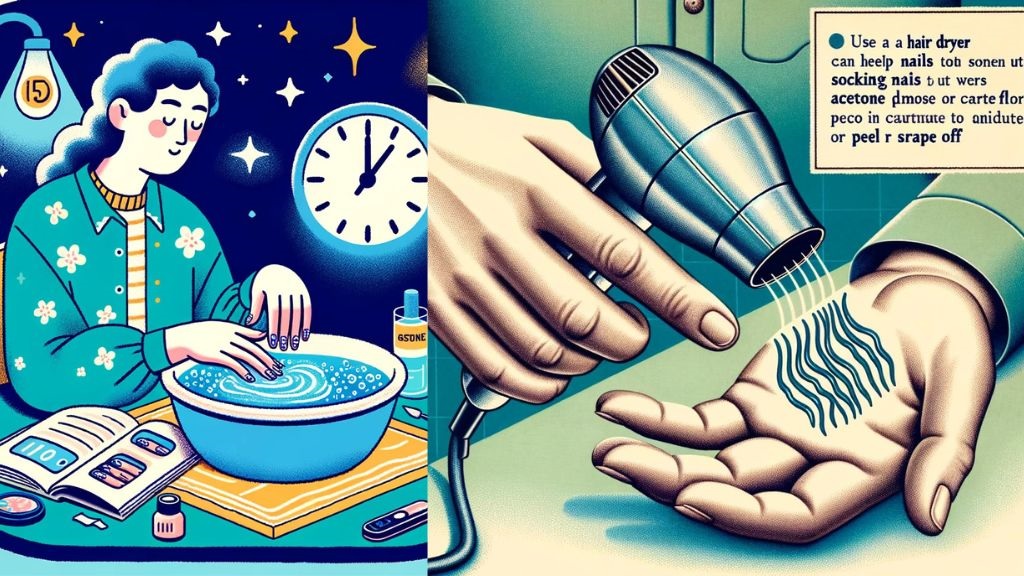
Using a hair dryer as a direct substitute for soaking in acetone depends on the task you’re aiming to accomplish. Acetone is primarily used for its solvent properties, effectively dissolving certain types of substances like nail polish, adhesives, and some plastics. The heat from a hair dryer, on the other hand, can soften or melt certain materials, making them easier to remove or manipulate, but it won’t dissolve them in the same way acetone does.
For Nail Polish Removal
- Not Advisable: A hair dryer is unlikely to effectively remove nail polish. The heat might make the polish more pliable, but it won’t dissolve it for easy removal. Traditional nail polish remover or non-acetone alternatives are best for this task.
For Adhesive Removal
- Potentially Useful: Heat can soften many types of adhesive, making it easier to scrape or peel them away from surfaces. A hair dryer can be useful in this scenario, especially for removing labels, stickers, or temporary bonding materials. However, for adhesives that are chemically soluble in acetone, the hair dryer won’t offer the same dissolving action.
For Plastic Reshaping or Repair
- Potentially Useful: Heat can make certain plastics more flexible, allowing for minor adjustments or repairs. This can be helpful for bending plastic back into shape or fitting plastic parts together. However, care must be taken not to overheat and damage the material.
Safety Considerations
- Avoid Excessive Heat: Using a hair dryer on sensitive materials or in volatile environments (e.g., near flammable substances) should be done with caution to prevent damage or fire hazards.
- Material Sensitivity: Not all materials respond well to heat; some might warp, melt, or degrade. Always test a small, inconspicuous area first.
While a hair dryer might offer a workaround for tasks like softening adhesives or reshaping plastics, it is not a substitute for the chemical action of acetone in dissolving substances. For each specific task, evaluate the goals and properties of the materials involved to choose the most appropriate method, whether it’s chemical dissolution with acetone or physical manipulation with heat.
Conclusion:
Proper soaking time is crucial for efficient and safe gel nail removal. Following the official guidelines outlined above will help you achieve optimal results without causing damage to your natural nails. Remember, every individual’s nails and gel thickness may vary, so adjust the soaking time accordingly. By adhering to these guidelines, you can enjoy a hassle-free and successful gel nail removal process.
- #1 How to do DIY gel nails for beginners at home
- #1 Debunking the Myths: Do gel nails ruin your nails?
- [ The average ] How much do nail techs make a year?
- #1 When is national nail tech day | 2027
- Comprehensive guide are pedicures safe during pregnancy







 to have themselves prettified
to have themselves prettified
Add comment